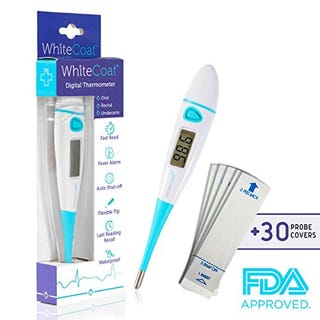How to Get Rid of a Fever Fast at Home
This article was medically reviewed by Raj Dasgupta, MD, an assistant professor of clinical medicine and a member of the Prevention Medical Review Board, on October 8, 2019.
Even though fevers are a literal pain to deal with, think of them as your body's early warning system. Most fevers are caused by infections, so your body jacks up the temperature by moving blood from the surface of your skin toward the interior of your body instead.
However, "the body does not lose the ability to regulate temperature during a fever. It simply regulates body temperature at a higher set point," explains Raj Dasgupta, MD, an assistant professor of clinical medicine at the University of Southern California Keck School of Medicine. "When a fever develops, body temperature rises toward the new higher set point."
While 98.6°F is considered a normal temperature, that can be flexible. Everyone has their own "normal" temperature, which actually fluctuates up and down throughout the day. Eating food, wearing excess clothing, feeling really excited, and vigorous exercise can all spike your body temperature. But if your temperature hits 100°F, consider it a mild fever, says Nita Parikh, MD, an internal medicine specialist with Community Care Physicians in Latham, New York.
Once your fever "breaks," the set point returns to normal, and your temperature starts to decrease by dissipating heat through sweating and dilating blood vessels in the skin. "The human body regulates temperature by keeping a tight balance between heat gain and heat loss," says Dr. Dasgupta. "Your temperature regulation system is more analogous to the operation of a home furnace, as opposed to the function of an air conditioner."
Whether you are dealing with the flu, a cold, pneumonia, or inflammatory condition, read on to find out the fever home remedies that can help you feel better while your body tries to find its balance.
First, how to tell if you have a fever

White Coat Fast Reading Digital Thermometer
To find out if you have a fever, you need to take your temperature using a thermometer. Wait at least 15 minutes after eating or drinking anything, smoking, or taking a hot bath before taking an oral reading, since this can alter mouth temperature and cause inaccurate readings. Then, follow these steps:
- Before using a thermometer, hold it by the top end (not the bulb) and shake it with a quick snap of the wrist until the colored dye is below 96°F. If you're concerned about dropping and breaking the thermometer, do this over a bed, Stephen N. Rosenberg, MD, author of The Johnson & Johnson First-Aid Book.
- Place the digital or glass thermometer under your tongue in one of the "pockets" located on either side of your mouth rather than right up front. These pockets are closer to blood vessels that reflect the body's core temperature.
- Hold the thermometer in place with your lips, not your teeth. Breathe through your nose rather than your mouth so that the room temperature doesn't affect the reading.
- Leave the thermometer in place for at least 3 minutes (some experts favor 5 to 7 minutes). After use, wash a thermometer in cool, soapy water or wipe down with rubbing alcohol. Never use hot water or store it near heat.
How to get rid of a fever

Towfiqu Photography Getty Images
1. First, wait it out.
If you do have a fever, remember this: Fever itself is not an illness—it's a symptom of one. So, in essence, your body's natural defenses can actually shorten an illness with its quick response and increase the power of antibiotics. These natural processes should be weighed against the discomfort involved in not medicating a slight fever and letting it run its course, says Dr. Rosenberg.
2. Hydrate, hydrate, hydrate.
When you're hot, your body sweats to cool you down. But if you lose too much water—as you might with a high fever—your body turns off its sweat ducts to prevent further water loss, making it more difficult for you to cope with your fever. The moral of this story: Drink up. In addition to plain water, experts favor the following:
Watered-down juice: Straight juice, no matter how nutritious, is too concentrated to drink in any quantity when you have a fever and may cause diarrhea. Always dilute 100 percent fruit or vegetable juice with 1 part juice to 1 part water to make it easier for your body to absorb.

Organic Linden Blossom Tea
Good Nature amazon.com
$9.99
Linden tea: Although any tea will provide needed fluid, several are particularly suited for fever, says Gale Maleskey, MS, RD. One combination she likes is thyme (antibacterial), linden flowers (promotes sweating), and chamomile flowers (reduces inflammation). Steep 1 teaspoon of the mixture in 1 cup of freshly boiled water for 5 minutes. Strain and drink warm several times a day. Linden tea by itself is also good, she says, and can induce sweating to break a fever. Use 1 tablespoon of the flowers in 1 cup of freshly boiled water for 5 minutes. Strain and drink hot often.
Willow bark tea: This bark is rich in salicylates (aspirin-related compounds) and is considered "nature's fever medication," Maleskey says. Brew into a tea and drink in small doses.
3. Opt for ice.
If you're too nauseated to drink, you can suck on ice. For variety, freeze diluted fruit juice in an ice-cube tray.
4. Cool down with wet compresses.
Wet compresses help reduce your body's temperature output. Ironically, hot, moist compresses can do the job as well. If you start to feel uncomfortably hot, remove those compresses and apply cool ones to the forehead, wrists, and calves. Keep the rest of the body covered. If the fever rises above 103°F, don't use hot compresses at all. Instead, apply cool ones to prevent the fever from getting any higher. Change them as they warm to body temperature and continue until the fever drops.
5. ...or trying sponging off instead.
Evaporation also has a cooling effect on body temperature. Try dabbing cool tap water onto the skin to help dissipate excess heat, says Mary Ann Pane, RN, a nurse clinician in Philadelphia. Although you can sponge the whole body, she says, pay particular attention to spots where heat is generally greatest, such as the armpits and groin area. Wring out a sponge and wipe one section at a time, keeping the rest of the body covered. Body heat will evaporate the moisture and cool the skin.
6. Pop an OTC pain reliever.

Advil Pain Reliever/Fever Reducer Coated Tablets
If you're very uncomfortable, take an over-the-counter pain reliever. For adults, aspirin, acetaminophen, or ibuprofen can be taken according to package directions. The advantage of acetaminophen and ibuprofen over aspirin is that fewer people experience side effects.
So which one should you take? All are effective, but some work better for particular ailments. For example, aspirin and ibuprofen are common nonsteroidal anti-inflammatory drugs (NSAIDs), so they're effective at reducing muscle pain and inflammation. Acetaminophen is recommended if you have gastrointestinal sensitivity or are allergic to aspirin. It doesn't work as well as NSAIDs for inflammation and muscle aches; however, it's a safer drug to use and has minimal side effects, as long as it's taken in the proper dosage.
7. Dress the part.
Use common sense as far as clothing and blankets go, says Pane. If you're very hot, take off extra covers and clothes so that body heat can dissipate into the air. But if you have a chill, bundle up until you're just comfortable.
8. Take your time with eating.
Don't fret over whether you should feed a fever or starve one—just drown it. "Most people don't want to eat when they have a fever, so the important thing is fluids," Maleskey says. Once your appetite starts to return, eat what appeals to you. Toast, scrambled eggs, chicken soup, and vanilla pudding all go down easy as part of your recuperation. (For more inspiration, here are the best foods to eat when you are sick.)
When should you see a doctor about your fever?
Temperatures of 102°F or higher may be serious, particularly if you are also feeling sick with other symptoms. Adults with chronic illnesses, such as heart or respiratory disease, may not be able to tolerate prolonged high fevers. See your doctor if you experience one or more of the following, per our experts and the Centers for Disease Control and Prevention:
- Headache with stiff neck
- Severe coughing or vomiting
- Pain taking a deep breath or difficulty breathing
- Facial pain
- Skin rash
- Unexplained bruising or bleeding
- Persistent diarrhea
- Yellow or green discharge from the nose
- Temperature higher than 101°F that lasts more than 2 days or fails to respond at least partly to treatment
- Temperature higher than 103°F under any condition
Like what you just read? You'll love our magazine! Go here to subscribe. Don't miss a thing by downloading Apple News here and following Prevention. Oh, and we're on Instagram too .
This content is created and maintained by a third party, and imported onto this page to help users provide their email addresses. You may be able to find more information about this and similar content at piano.io
How to Get Rid of a Fever Fast at Home
Source: https://www.prevention.com/health/a20429676/10-fever-remedies/